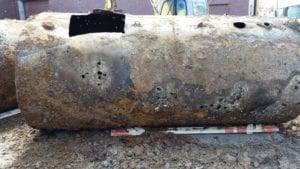 Due to the inherent environmental and regulatory risks associated with gasoline, it is vitally important to have a robust environmental due diligence process when purchasing a retail gasoline station. We frequently answer three questions about environmental due diligence in these types of transactions:
Due to the inherent environmental and regulatory risks associated with gasoline, it is vitally important to have a robust environmental due diligence process when purchasing a retail gasoline station. We frequently answer three questions about environmental due diligence in these types of transactions:
- Why is it my environmental risk when I did not cause any contamination?
- What are the types of environmental risks associated with gas stations?
- How can I protect myself from environmental risks?
Why Purchasing a Property Poses an Environmental Risk
In 1980, congress passed the Comprehensive Environmental Response, Compensation, and Liability Act—otherwise known as CERCLA or Superfund. Through CERCLA, the Environmental Protection Agency (EPA) was granted power to seek out those parties responsible for any release of contaminants and assure their “cooperation” in the cleanup. The courts have applied a strict liability standard under CERCLA. Liability is imposed regardless of fault and can be imposed retroactively (i.e., before CERCLA was enacted). The liability is also joint and several, meaning that liability for contaminants can be imposed regardless of relative contribution, including merely purchasing a property.
Types of Environmental Risks Associated with Gas Stations
There are three types of environmental risks associated with gas stations: subsurface contamination, regulatory compliance, and business legacy.
Subsurface Contamination
Subsurface contamination may result from current or past releases of gasoline or petroleum products from storage tank systems, hydraulic lifts, car washes, service bays, etc. They may also include releases from historic operations at the property that are unrelated to the current facility. Environmental issues may also exist from former operations at adjacent properties.
These types of spills may have caused soil, groundwater, and soil vapor contamination. The liabilities associated with petroleum products pose hazards in the form of impacted water supplies, contaminated surface water bodies, and explosive or toxic vapors.
Building occupants, construction or maintenance workers, and surrounding homes or businesses may be impacted. Migration of contaminants to offsite properties and sensitive receptors can generate third party liabilities.These liabilities can far exceed the value of the purchased property.
Regulatory Compliance
Regulatory compliance issues, such as compliance with tank regulations, permits, and Notices of Violation (NOVs), may require substantial capital expenditures for equipment upgrades necessary to meet current regulatory standards. Upgrade requirements may include tanks, spill containment devices, tank monitoring equipment, testing, registration, and operator training.
Business Legacy
Business legacy issues are related to properties formerly associated with a business entity. Depending upon the legal setting, these risks may include broader liabilities carried by the business that may not be site-specific (e.g., environmental issues associated with previously owned properties, disposition of hazardous and non-hazardous waste, waste disposal facilities, third-party legal action, etc.)
How to Mitigate Environmental Risks
Environmental risks from subsurface contamination can be mitigated by focused environmental due diligence evaluations.
Documented industry standards exist for evaluating the potential for a subsurface environmental condition to exist through non-intrusive means (ASTM E1527), and for confirming if a suspected condition exists using intrusive investigation techniques (ASTM E1903). These investigations have been termed Phase I and Phase II Environmental Site Assessments (ESAs), respectively.
The 2002 Brownfields Amendments to CERCLA (the “Small Business Liability Relief and Brownfields Revitalization Act”) created a new landowner liability protection from CERCLA. The Brownfields Amendments added specific criteria for conducting All Appropriate Inquiry (AAI) which later became known as the AAI rule. The AAI Rule provides an escape from liability called the “innocent landowner defense,” but this defense can only be used to escape liability if “appropriate due diligence” was conducted prior to the acquisition of the property. The Phase I and Phase II ESAs meet the AAI rule requirements.
Risks from regulatory compliance issues can be mitigated by a thorough evaluation of tank system components and records. Regulatory and industry standards dictate acceptable tank system component technology, as well as ongoing testing, maintenance, and record keeping requirements. Testing and maintenance records may provide an indication of the seller’s tank management practices and indicate if leaks have occurred historically.
Tank system tightness testing performed in conjunction with the asset transaction can confirm current tank system integrity.
Additional consideration should be component age and projected end of life (determined by regulatory standards, warranty expiration, or performance history) since the replacement of tank systems represents a significant capital expenditure.
Business legacy risks are less a focus of environmental due diligence and more for the legal due diligence team. The legal team should structure the asset acquisition to minimize environmental risks in relation to purchase costs, assumed liabilities and insurance options.
Bottom Line: Do Your Homework
Investigating and mitigating environmental and regulatory hazards can present a significant financial burden for the responsible party and asset buyers may unknowingly assume responsibility if proper due diligence is not exercised.
Liability mitigation cost forecasts and cash flow scenarios can be developed using probabilistic cost models to aid in the negotiations between buyer and seller. Asset purchase agreement language can clearly define responsibility for future actions.
A focus on these due diligence areas prior to the asset transaction closing will help reduce surprises and minimize unexpected costs associated with subsurface impacts and/or tank system upgrades. By understanding the risks, and conducting research and appropriate testing, you can ensure a smooth transition and a successful transaction.


